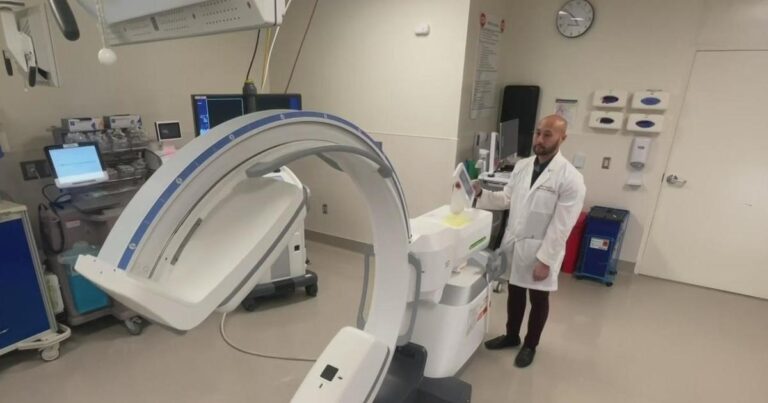SACRAMENTO — Breakthrough technology is helping UC Davis Medical Center treat more cases of lung cancer at an earlier stage. The hospital system is the first in Northern California to combine two cutting-edge advanced imaging technologies that can detect lung abnormalities faster and safer.
Lung cancer is the leading cause of cancer deaths in the U.S. and is expected to claim the lives of 125,000 Americans this year alone, which is why doctors are calling UC Davis Health’s implementation of these new technologies groundbreaking.
“This is the Cios Spin. It takes 3D images of the patient’s lungs,” Dr. Chin Fan told CBS13 as he showed the machine.
It works in conjunction with a robotic-assisted bronchoscopy system called Ion.
“The device has a 3.5-millimeter catheter attached to it, and the controller guides the device down the patient’s airway to the nodule,” Fan demonstrated. “The Ion robotic system helps navigate the robotic camera to the location.”
Dr. Fan is director of the Interventional Pulmonology Program at UC Davis Health.
The combined capabilities of these two machines mean that potentially cancerous lung nodules can now be found much sooner than before.
“It updates the location of the nodule in real time, just like a GPS does when you’re stuck in traffic. It updates you on where you need to go, so you can do the biopsy exactly where it needs to be done,” Fan said.
Why is that revolutionary?
Lung cancer is tiny in the early stages.
“You can imagine that finding a 10-millimeter nodule in the lung is very difficult,” Fan said. “It’s like looking for a needle in a haystack.”
This is why lung cancer is the deadliest cancer worldwide.
This cutting-edge test has already saved many lives through early diagnosis.
“Since we introduced this technology, we’ve seen more stage 1 lung cancer diagnoses than ever before,” Fan said.
Since UC Davis Health first installed the Cios Spin 3D imaging device in 2022, it has been used for more than 400 biopsies and to diagnose 107 patients with stage 1 lung cancer.
This represents a 49% increase in stage 1 diagnoses compared to stages 3 and 4 before this innovation.
“Before this technology existed, I would look at a patient’s CT scan and say to myself, there’s no way it’s safe to diagnose this. It’s like a coin toss for the patient to get an answer or not, and they’ll be sent off to a different treatment. But now, when I see these tiny modules, I no longer hesitate, because I know that the technology we have is the best technology to date for diagnosing patients with stage 1 lung cancer,” Fan said.
For Dr. Hwang, this contrasts with a time when he had no choice but to tell most patients they had lung cancer, and that it was progressing, with dismal survival rates for such cases.
“But now we’re having a different kind of conversation, which is, ‘Yes, you have lung cancer. The good news is, it’s stage 1, so you’re curable,'” Fan said.
There is new hope on the horizon that a single spin of Cios promises progress against some of the deadliest cancer diagnoses.
California has the lowest lung cancer screening rates in the country, worrying doctors.
Dr. Fan hopes this story will raise awareness about how important it is for people who are eligible for lung cancer screening to get screened annually.
If a routine exam reveals an abnormality, the patient’s doctor can refer them to UC Davis for this advanced 3D test, which is covered by insurance companies.
UC Davis Health plans to install a second Cios Spin machine in the near future, which doctors hope will help break down barriers to lung cancer treatment in our region.
For more information, visit the UC Davis Health website.


